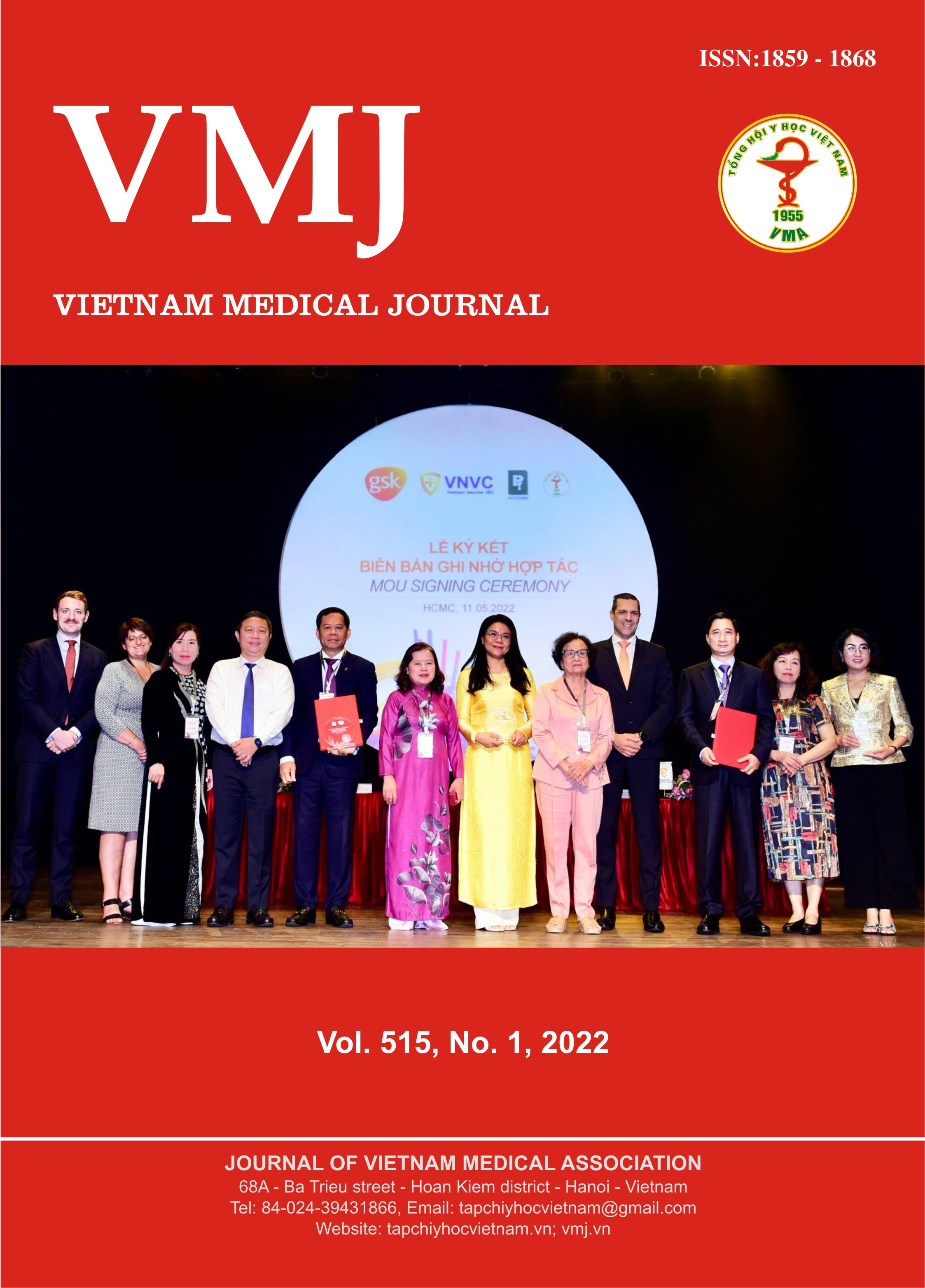EFECTS OF LISINOPRIL AND AMLODIPIN IN COMBINATION FOR THE TREATMENT OF HYPERTENSION WITH PULSE WAVE VELOCITY VP PLUS 1000 METER
Nội dung chính của bài viết
Tóm tắt
Aim: The aim of this study was to evaluate the antihypertensive efficacy of lisinopril and amlodipine in combination which were measured by the pulse wave velocity meter. Research objects and Methods: 40 patients with primary hypertension, mean age 69.18 ± 10.4 years. All patients had their blood pressure, pulse wave velocity (baWPV), ankle brachial index measured by pulse wave velocity VP Plus 1000 meter before receiving the treatment. All patients were then given the Lisonorm combination pill (lisinopril 10 mg and amlodipine 5 mg) for 4 weeks. After 4 weeks, the patients was measured again with the same device (the pulse wave velocity of VP Plus 1000 meter). Results: After 4 weeks, the values of the Right arm blood pressure decreased: 26.58 ± 9.51 mmHg/ 8.6 ± 4.47 mmHg; Left arm blood pressure decreased: 26.88 ± 11.27/13.55 ± 8.15mmHg; Right ankle blood pressure decreased: 23.75 ± 11.78/10.75 ± 6.64mmHg; Left ankle blood pressure decreased: 30.33 ± 16.64/13.6 ± 9.28mmHg; The rate of patients with the target blood pressure was 72.5% (29/40 patients). Right baPWV decreased 593.65 ± 416.59 cm/s; Left baPWV decreased 585.4 ± 447.19 cm/s. Conclusion: The combination of lisinopril 10mg and amlodipine 5mg effectively had decreased the blood pressure in both extremities and pulse wave velocity, and had reduced vessel wall stiffness when it was measured by the pulse wave velocity VP Plus 1000 meter.
Chi tiết bài viết
Từ khóa
Hypertension, Combination pill (lisinopril and amlodipine), Arm blood pressure (BP), Ankle blood pressure, Brachial ankle pulse wave velocity (baWPV), Target blood pressure
Tài liệu tham khảo
2. Attila Ko´nyi et al. (2016), ”Safety and effectiveness of combined antihypertensive and cholesterol-lowering therapy in high-/very high-risk patients”, J Comp Eff Res, 5(4):355-64.
3. Azra Mahmud, John Feely (2002), Reduction in arterial stiffness with angiotensin II antagonist is comparable with and additive to ACE inhibition, American Journal of Hypertension, Volume 15, Issue 4. April 2002: 321-325; http://doi.org/10.1016/S0895-7061(01)02313-5
4. Bryan William, Giuseppe Mancia et al (2018), 2018 ESC/ESH Guideline for the management of arterial hypertension, European Heart Journal (2018), 39, 3021-3104, doi: 10.1093/eurheart/ehy339
5. Carolina Guerrero-Garcia, Alberto Francisco-Guerra (2018). Combination therapy in the treatment of hypertension. Drugs in Context 2018; 7:212531. DOI:10.7573/dic.212531
6. Chowdhury R, Khan H, Heydon E, Shroufi A, Fahimi S, Moore C, Stricker B, Mendis S, Hofman A, Mant J, Franco OH. Adherence to cardiovascular therapy: a meta-analysis of prevalence and clinical consequences. Eur Heart J. 2013; 34:2940-2948. doi: 10.1093/eurheartj/eht295.
7. Daniel Grassi et al (2008), Hypertensive Urgencies in the Emergency Department: Evaluating Blood Pressure Response to Resst and to Antihypertensive Drugs With Different Profiles, Journal of clinical hypertension, vol 10 No.9 September 2008: 662-667; doi:10.1111/j.1751-7176.2008.0001.x
8. Forouzanfar M.H. et al.(2017), “Global Burden of Hypertension and Systolic Blood Pressure of at Least 110 to 115 mmHg, 1990-2015”, The Journal of the American Medica Association, 317(2): 165-182.
9. Jamerson K, Weber MA, Bakris GL et al (2008),” Benazepril plus amlodipine or hydrochlorothiazide for hypertension in high-risk patients”, N. Engl. J. Med. 359(23), 2417-2428. doi: 10.1056/NEJMoa0806182.
10. Law MR, Wald NJ, Morris JK, Jordan RE. Value of low dose combination treatment with blood pressure lowering drugs: analysis of 354 randomized trials.BMJ. 2003; 326:1427. doi: 10.1136/bmj.326.7404.1427.
11. Minh Huynh Van, Viet Nguyen Lan et al (2020), “Asian management of hypertension: Current status, home blood pressure, and specific concerns in Viet Nam, Journal Clinica Hypertension 2020:22:519-521. DOI:10.1111/jch.13780
12. Mur Naidu, PR Usha, Tramesh Kumar Rao, JC Shobha (2000), “Evaluation of amlodipine, lisinopril, and a combination in the treatment of essential hypertension”, Postgrad Med J., 76(896): 350-353. doi.org/10.1136/pmj.76.896.350.
13. Ronald D.Smith and Pavel J. Levy (2008), New techniques for assessment of vascular function, Therapeutic Advances in Cardiovascular Disease (2008) 2(5) 373-385,doi:10.1177/1753944708091775
14. Sandeep P Kishor et al (2018), Fixed-dose combinations for hypertension, The Lancet, Volume 392, Issue 10150: 819-820, September 08, 2018 DOI: https://doi.org/10.1016/S0140-6736(18)31814-2
15. Semagina, I. Kotovskaya, Y. Kobalava (2015), ”Effects of Lisinopril/ amlodipine single pill combination on ambulatory brachial and central blood pressure in hypertensive subjects with non- alcoholic fatty liver diese”, Journal of Hypertension, Vol33:p199.DOI: 10.1097/01.hjh.0000467948.55663.a6.
16. Sergey V. Nedogoda, et al. (2018),” Blood pressure control and vascular protection with a fixed-dose combination of lisinopril + amlodipine + rosuvastatin in hypertensive patients”,Vessel Plus, Vol2:37. doi.org/10.20517/2574-1209.2018.36
17. Tetsuya Ichihara, et al. (2005),”Selective angiotensin receptor antagonism with valsartan decreases arterial stiffness independently of blood pressure lowering in hypertensive patients”, Hyperten Res. 28(12):937-43. doi: 10.1291/hypres.28.937.
18. Vinay.K.Balt, et al. (2012),“Management of hypertension with the fixed combination of perindopril and amlodipine in daily clinical practice”, American Journal of Cardiovascular Drugs 9, 135-142. doi: 10.1007/BF03256570.
19. Wald D.S, Law M, Morris JK, Bestwick JP, Wald NJ. Combination therapy versus monotherapy in reducing blood pressure: meta-analysis on 11,000 participants from 42 trials. Am J Med. 2009; 122:290-300. doi: 10.1016/j.amjmed.2008.09.038.
20. WHO (2021), Guideline for the pharmacological treatment of hypertension in adults; License: CC BY-NC-SA 3.0 IGO; DOI: http://www.WHO.int/about/licencing


